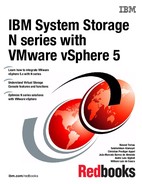

Introduction to virtualization
Virtualization helps you take control of your infrastructure. With virtualization, you can see and manage your computing resources in ways that offer more flexibility because you are not restricted by implementation, location, or physical packaging. By using virtualization, you have a logical, rather than a physical, view of data, computing power, storage capacity, and other resources. By gaining greater control of your infrastructure, you can improve cost management.
This chapter describes the various types of virtualization. It includes the following topics:
2.1 Advantages of virtualization
Businesses are pursuing financial savings through both server and storage consolidation. The consolidation is achieved by using virtualization. Virtualization is the abstraction of a physical resource into a virtual resource that is decoupled from the underlying hardware. Consolidation of server and storage hardware by using virtualization offers a return on investment (ROI) for the business.
Although cost savings is a primary driver for initial virtualization deployment, the full value of virtualization lies in its ability to offer the following advantages:
•Improved total cost of ownership (TCO):
By decreasing management costs and increasing asset utilization, you can experience a rapid ROI with virtualization. In addition, by virtualization of resources, you can make them easier to migrate or fail over to other physical devices or locations. Thus you can enhance system availability and help lower the cost and complexity of disaster-recovery solutions.
•Increased flexibility:
Virtualization supports the pooling of resources that can be managed centrally through an enterprise hub to better support changing business requirements dynamically.
•Enabled access through shared infrastructure:
Virtualization provides a resilient foundation and shared infrastructure that enables better access to infrastructure and information in support of business applications and service-oriented architectures (SOA).
Companies of all sizes are aggressively adopting virtualization solutions to help in the following areas:
•Infrastructure simplification:
Virtualization can help control infrastructure sprawl through the deployment of virtual servers and storage that run securely across a shared hardware environment. Virtualization not only helps with server consolidation, but also server containment when deploying new systems. Consolidating to a virtual infrastructure can enable you to increase server utilization rates from 5% to 15% to over 70%, thus helping improve ROI. In addition, a simplified infrastructure can help lower management costs with a common management platform and tooling.
•Rapid application deployment:
Virtualization can help enable rapid infrastructure provisioning (in minutes instead of days). It can help developers speed application test and deployment, enhance collaboration, and improve access to the infrastructure. The ease and flexibility of creating and reconfiguring guest operating systems helps development and test environments to realize significant benefits from virtualization.
•Business resiliency:
Virtualization can help IT managers secure and isolate application workloads and data within virtual servers and storage devices for easier replication and restoration. This added resiliency can provide IT managers with greater flexibility to maintain a highly available infrastructure while performing planned maintenance. It also helps in configuring low-cost disaster recovery solutions.
Virtualization technologies solve many traditional backup issues, because they decouple the bindings between the operating system (with the application and data) and the underlying hardware. For example, you can have a different hardware topology in the recovery site, both in terms of the number of servers and the configuration of those servers. You can also still boot all your guests on the two different data centers.
With virtualization, you can freely mix and match technologies through common management tools for managing distributed heterogeneous resources. This added freedom offers capabilities to lower switching costs, add flexibility and freedom of choice, and mask complexity. Managing each computer or resource together virtually, instead of separately, allows for significant improvements in utilization and administrative costs.
So to summarize, here are the main reasons why you should use virtualization:
•To get more out of your hardware resources
•To reduce IT costs
•To increase hardware and applications availability improving business continuity
•To increase operational flexibility
•To improve desktop manageability and security
2.2 Storage virtualization
The amount of data and information that is being generated by businesses continues to grow. The IT data center manager must deal with this high rate of growth and, at the same time, look for ways to reduce costs. Storage consolidation helps the data center manager deal with the rapid growth and costs concerns. Increasing the utilization of the storage hardware, similar to what was explained for the server hardware, is cost-effective, and helps meet the growing demand. Storage consolidation is the allocation or provisioning of shared storage resources.
This consolidation is enabled by storage virtualization (Figure 2-1). Shared storage is connected to the servers by using Fibre Channel or IP-based networks.
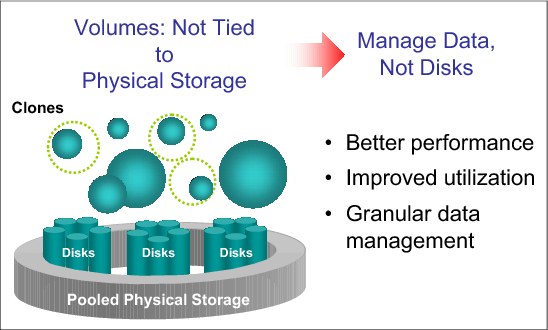
Figure 2-1 Storage virtualization
Storage virtualization software, which is similar in concept to server virtualization, abstracts the storage hardware volumes of data into a logical or virtual view of the volume. Using N series hardware with storage virtualization gives the data center a method to support storage provisioning, independent of the underlying storage hardware.
Storage virtualization can enable data sharing, data tiering, improved storage hardware utilization, improved availability, and disaster recovery capabilities. Storage virtualization software separates the representation of the storage to the operating system from the physical device. Utilization rates of storage are likely to be improved when moving toward network-based storage that is virtualized.
2.3 Network virtualization
If physical server farms are consolidated into virtual server farms, parts of the physical network can be replaced by a virtual network, saving money and reducing management complexity. Network performance and bandwidth between the servers is increased, enabling new data-intensive applications. Although network virtualization is not covered in detail in this IBM Redbooks publication, this section provides a brief overview of it. It also highlights the various technologies within the platform-specific topics.
Business-critical applications require more efficient management and use of network resources regarding performance, resource usage, people cost, availability, and security. Network virtualization includes the ability to manage and control portions of a network that can even be shared among different enterprises, as individual or virtual networks. At the same time, isolation of traffic and resource utilization is maintained.
Network virtualization includes technologies such as Virtual Private Networks (VPNs), IBM HiperSockets™, Virtual Networks, and VLANs. It also includes the ability to prioritize traffic across the network, through quality of service (QoS), to ensure the best performance for business-critical applications and processes. Instrumentation of network resources and operations, such as Simple Network Management Protocol (SNMP), can be abstracted across the server and networking devices. These technologies are key enablers for on-demand behavior.
The N series assists with this network virtualization with its ability to support multiprotocols and transports:
•Common Internet File System (CIFS)
•Network File System (NFS)
•iSCSI
•Fibre Channel Protocol (FCP)
•Fibre Channel over Ethernet (FCoE)
As illustrated in Figure 2-2, this virtualization of protocols enables consolidation of storage and reduces any connection impact to the existing network.
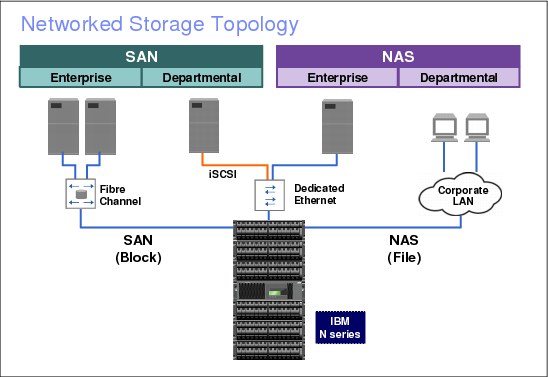
Figure 2-2 Multiprotocol N series
2.4 Application virtualization
Application virtualization addresses application-level workload, response time, and application isolation within a shared environment. Application virtualization complements server, storage, and network virtualization as illustrated in Figure 2-3.
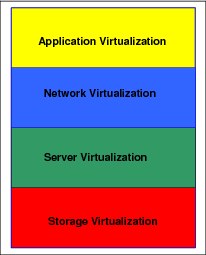
Figure 2-3 Virtualization stack
With application virtualization, businesses can push the boundaries of their IT infrastructures further for greater agility, cost savings, operational efficiency, and manageability. Also, CIOs and IT administrators can literally do more with less. With application virtualization, data centers can run applications on any application server in a common resource pool. Furthermore, administrators can deploy resources quickly and seamlessly during peak periods and in response to unforeseen demand for mission-critical applications. In addition, data administrators can achieve application response times and service levels that meet service level agreements.
2.5 Server virtualization
With virtualization, one computer does the job of multiple computers, by sharing the resources of a single computer across multiple environments (Figure 2-4). By using virtual servers and virtual desktops, you can host multiple operating systems and multiple applications locally and in remote locations, freeing you from physical and geographical limitations.
Server virtualization also offers energy savings and lower capital expenses because of more efficient use of your hardware resources. You also get high availability of resources, better desktop management, increased security, and improved disaster recovery processes when you build a virtual infrastructure.
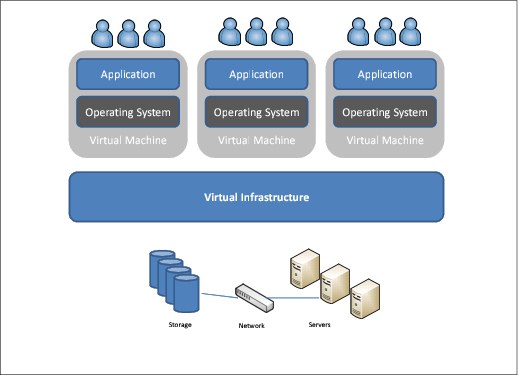
Figure 2-4 Server virtualization
The virtualization concept became more popular with the introduction of hypervisors (software responsible for the virtualization layer) in the x86 platform. However, server virtualization is not a new technology. It was first implemented more than 30 years ago by IBM as a way to logically partition mainframe computers into separate virtual machines. These partitions allowed mainframes to multitask (run multiple applications and processes at the same time). However, because of the high cost of the mainframes, the virtualization technology did not become popular.
The broad adoption of Microsoft Windows and the emergence of Linux as server operating systems in the 1990s established x86 servers as the industry standard. The growth in x86 server and desktop deployments introduced new IT infrastructure and operational challenges. Virtualization in the x86 platform allowed companies to centralize the management of servers and desktops, together with a reduction in cost of management.
2.5.1 VMware vSphere
The VMware approach to virtualization inserts a thin layer of software directly on the computer hardware (with the bare metal hypervisors as ESXi). Or it can be done on a host operating system (with the VMWare Server product). This software layer allocates hardware resources dynamically and transparently. Thus it enables multiple operating systems to run concurrently, each unaware of the others, on a single physical computer.
The VMware vSphere, combined with IBM System Storage N series storage and its storage virtualization capabilities, brings several benefits to data center management:
•Server consolidation and infrastructure optimization:
Virtualization makes it possible to achieve higher resource utilization by pooling common infrastructure resources and breaking the “one application to one server” model.
•Physical infrastructure cost reduction:
With virtualization, you can reduce the number of servers and related IT hardware in the data center. The benefit is reductions in real estate, power, and cooling requirements, resulting in lower IT costs.
•Improved operational flexibility and responsiveness:
Virtualization offers a new way to manage IT infrastructure. It can help IT administrators spend less time on repetitive tasks, such as provisioning, configuration, monitoring, and maintenance.
•Increased application availability and improved business continuity:
You can reduce planned downtime and recover quickly from unplanned outages. You have the ability to securely back up and migrate entire virtual environments with no interruption in service.
•Storage savings:
By taking advantage of the N series thin provisioning capability, you can allocate the space of the actual used files only (see Figure 2-5).

Figure 2-5 Thin provisioning savings
•Rapid datacenter deployment:
With the LUN clone capability of N series system, you can quickly deploy multiple VMware hosts in the data center.
2.5.2 Implementation example
This section provides an example of one of several configurations that were used and implemented in the development of this Redbooks publication.
The environment has the following setup:
•Server: IBM System x3650 system
•Storage: 2 x IBM System Storage N series 6070
•iSCSI used as Storage protocol for the connection between the storage system and the server
•Ethernet switch
•Network:
– 1-Gigabit NIC for VMware Service Console
– 1-Gigabit NIC for VMotion
– 1-Gigabit NIC for the virtual machines
•Virtualization software:
– VMware ESXi 5.1
– VMware vCenter 5.1
|
Network and storage redundancy: This example does not consider redundancy for network and storage.
|
Figure 2-6 shows the environment used to write this book.

Figure 2-6 The environment used to write this book
..................Content has been hidden....................
You can't read the all page of ebook, please click here login for view all page.
